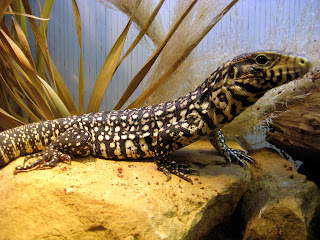Tuesday, November 22, 2011
Five-Alarm Frog
Article from June 2008. I chose this article because not only did the name stick out but the appearance as well. Dyscophus Antongilii, better known as the Tomato Frog. The article was very informative on these frogs, I never heard of them before so it was interesting to read about their origins and why in fact they are called Tomato Frogs. It talked about where they are commonly found and their popular morph in pet trade. The article was fairly short but informative. It told of the proper morph that tells apart a real Tomato Frog and a false Tomato Frog. The females are more of a vibrant red where as the males are usually yellowish orange. They're are three common Tomato Frogs. The most common is Guineti. Next is Antongilii, which is the most colorful. Third is Insularis. I suppose the Tomato Frog isn't something that would be of interest to me. I guess I would say amphibians aren't something I have much experience in other then catching a toad here and there in my yard. I'm sure they can be purchased at any major reptile website and pet stores that specialize in reptiles and amphibians. The cost of Tomato Frogs can range from 50 dollars to in the hundreds. The different morphs would cause the price ranges to differ between the three different popular Tomato Frogs. Tomato Frogs are not endangered in the wild, but they aren't progressing either. There is not need for a permit to own a Tomato Frog, you buy one at your own risks. They can comfortably live in a 10 gallon tank, make sure there is enough moisture for them to be comfortable. They can be considered at a beginner level to keep. No real up keep or high maintenance that they hold. I found their colors to be very interesting. Very bright and noticeable. Which makes me wonder if they would last a in the wild.
Totally Tegus
Article from June 2008. I choose this article because we have a Argentine Tegu in our class named Bubba. He's a lover, when it's not feeding. I liked that the article had a section for the different types of Tegus. They had the scientific name and then explained each unique fact and information about them. So it wasn't just the Tegu breed over all but individuals too. I learned at lot more about Tegus. I learned their origins and history. Telling the different Tegus apart and their different morphs. Also each different needs they uphold. The only question I would present would be they only covered a number of Tegu breeds. Are there more then what listed or is there a limited number of Tegus? I would purchase a Tegu. Working with Bubba in the class shows me that they can be a great pet. But they do come with some behavioral problems. Each different breed has a different attitude. You have to be careful of what breed to choose to fit your comfort level and experience level. Tegus, like any reptile can be pricey. They can range from 700 dollars to thousands. They can be bought at Reptiles-N-Critters.com for about 800 dollars. Also at Tegusforsale.com for around $350 and above depending on breed of Tegu. There are many Tegu morphs and more being made yearly due to breeding different morphs together. There are the most popular though. Black and White Argentine Tegus, Yellow Tegus, Red Tegus, Blue Tegus, and All American Tegus are a`few of the more well known Tegu morphs. Tegus are not endangered or on the verge of being so. Since there are so many captive bred Tegus there is a good supply of them. There is no need for a permit to keep a Tegu. But it would be wise to know what you're getting yourself into before you invest in one. Do plenty of research and a back round on which ever breed you're looking at getting. These animals need room. They can't be kept in a closed area. At least a 7 foot, 8 foot tank to keep them happy. They are at least a medium level experienced animal to keep. Their not to difficult to keep, but you have to know what you're doing.
Subscribe to:
Comments (Atom)

